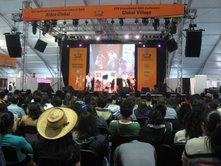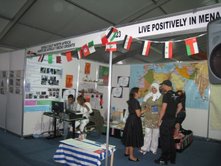Global Village Thrums with Activist Energy at IAC
The Global Village at Mexico City offers attendants, regardless of official status or ability to pay the IAC registration fee, the chance to make the conference their own.
Harm reduction and
human rights, violence against women, youth experiences with HIV, the
experiences of sex workers and indigenous peoples, wanted and unwanted
pregnancy among positive women, traditional healing, and spiritual renewal…just a few of the hundreds of issues debated, discussed, and addressed
through dance, painting, photography at the Global Village at this year’s International
AIDS Conference in Mexico City. Described by the GlobalVoice as
“the hub of activity and activism during the conference,” this space
is truly alive! I was one of many local residents who entered
this dynamic space as an active participant, committed to learning more
about grassroots activism around the world aimed at preventing HIV,
erasing HIV/AIDS discrimination and stigma from the map, and making
human rights a reality for all positive people. Anyone could enter,
regardless of our ability to pay, making it accessible to people who
could not afford the exorbitantly high registration fee. Those
of us without registration badges were prevented from entering the traditional
conference, with its lectures and “expert” panels, but we were able
to talk openly with people around the world about their real life experiences
related to discrimination, travel restrictions, isolation, and illness,
as well as ways of moving beyond and eradicating stigma, solidarity,
acceptance, inclusion, and their exercise of their human rights.
 After navigating the
After navigating the
maze of walkways leading to the Global Village, I entered its bright
euphonious space. Over 8000 square meters are covered with an impeccably
white tent. Inside, the Village features booths from organizations
coming from every region of the world. The sounds of discussions
and debates, workshops, live theatre and drumming, live radio show interviews
with positive people, the buzz of networking and strategizing fill its
space.
Eugenia Lopez-Uribe,
Global Village Coordinator and member of the International AIDS Society
México AC, reflects that the “Global Village provides an opportunity
for people to not just attend the conference, but to make
it their own. Paying the high registration fee is something
that only a privileged group of people can do. The GV is free and open
to all so everyone can take advantage of what this meeting has to offer.
The GV is a space where real people can talk about and work toward real
solutions. Dialogue is possible here, something that’s
not happening in the panel sessions.” Lopez-Uribe recognized
the spirit of solidarity with which the staff of the Centro Banamex
is working to make this enormous space one that meets the needs of all
participants.
The Global Village
at this 17th International AIDS conference in Mexico City
is by far the largest of the three GVs held so far in the world.
The first, held in a small “garage-like” space in Bangkok in 2004,
grew into a somewhat larger space for the 2006 Toronto conference.
This year’s mammoth village is testament to the persistence of community
groups around the world, demanding that their voices be heard and their
experiences included in strategies that are developed. Their presence
and participation exclaim that HIV/AIDS cannot be relegated exclusively
to medical and scientific discussions; that social, cultural, and political
issues must also be addressed and to do so, the voices of community
members must be heard.
Tamil Kendall, local
coordinator and international liaison for the Alliance for Gender Justice
AIDS 2008, which organized the Women’s Networking Zone (WNZ), described
the Global Village as a space “that ensures that there is a place
in the conference to gather and express the leadership and knowledge
of people affected and infected.” The WNZ, whose motto “All
WOMEN, All RIGHTS,” is the culmination of a year-long consultative
process among partners aimed at incorporating gender, and especially
women’s voices, into the discussions and debates related to HIV/AIDS
experiences. The feminization of AIDS absolutely requires that
women’s experiences and leadership are in the forefront of efforts,
a point emphasized by student volunteers in the WNZ, Isabel Arrastia
and Elizabeth Shaw from Loyola Marymount University in Los Angeles. 
Listening, acceptance
and inclusion are important dynamics that permeate the air of the GV.
People of all races, ethnicities, genders and gender/sexual orientations,
ages, classes and cultures intermingle and exchange ideas across experiences
and languages. “Acceptance is one of the keys to preventing
HIV transmission,” highlighted Luis Perelman of the Armario Abierto
in Mexico City, a project and bookstore dedicated to eradicating homo/bi/transphobia.
He continued, “If your family thinks that you’re worthless and disgusting,
will you really value your life and yourself? Will you really
engage in sex practices that help to protect you? If you’re
HIV+, will you really take your medications?” In a session sponsored
by the Armario and PFLAG, a Mexican mother spoke poignantly of her son’s
transformation from Jorge to Sabrina and how today her daughter lives
happily, openly and able to exercise her rights to have a family with
her partner in Catalan, Spain. Her mother remains in Mexico, determined
to create greater acceptance among communities in her country and to
demand laws and policies that guarantee the rights of all people, regardless
of their gender and sexual orientation.
Dialogue and mutual
learning characterize the Global Village. “This is a space where
money and one’s access to resources does not define one’s access
to information and opportunities for discussion,” emphasized Dinys
Luciano, Director of Development Connections, which focuses on addressing
the often-ignored link between HIV and violence against women.
“This space re-energizes me. There are so many ways that people
are presenting information and helping others to understand their realities—with
art, photography, dance and not just through one-way lectures.
Here you can focus more on processes, which are so important
for creating alliances.”
“This space is so
important for us, to connect to other people throughout the world.
It’s a space for the free flow of ideas and exchanges, which doesn’t
happen in the panels” — it was a sentiment shared by many of the people I
interviewed, including Marisa Brigati of the Sex Worker Outreach Project
in New York City and Hassan Cherry of the Health Care Association of
the MENA region. Hassan emphasized that this GV was the first
time that groups from MENA were present.
As Peter Piot, Executive
Director of UNAIDS, emphasized in the opening session, there is no technical
“fix” for HIV. What remains to be done in the HIV/AIDS movement
is the really difficult work of addressing the root causes of HIV and
AIDS, including sexism, racism, gender inequality, poverty, stigma and
discrimination; this can only be done with the active and creative participation
and leadership of communities throughout the world. This year’s
Global Village is providing an invaluable space for that to happen.
